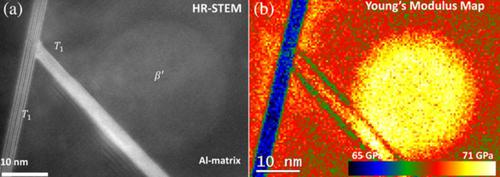当前位置:
X-MOL 学术
›
Microsc. Res. Tech.
›
论文详情
Our official English website, www.x-mol.net, welcomes your
feedback! (Note: you will need to create a separate account there.)
Application of aberration‐corrected scanning transmission electron microscopy in conjunction with valence electron energy loss spectroscopy for the nanoscale mapping of the elastic properties of Al–Li–Cu alloys
Microscopy Research and Technique ( IF 2.0 ) Pub Date : 2020-11-13 , DOI: 10.1002/jemt.23646 Muna S. Khushaim 1, 2 , Dalaver H. Anjum 3
Microscopy Research and Technique ( IF 2.0 ) Pub Date : 2020-11-13 , DOI: 10.1002/jemt.23646 Muna S. Khushaim 1, 2 , Dalaver H. Anjum 3
Affiliation

|
The stress and strain play an important role in strengthening of the precipitation‐hardened Aluminum (Al) alloys. Despite the determination of relationship between the mechanical properties and the precipitation existing in the microstructure of these alloys, a quantitative analysis of the local stress and the strain fields at the hardening‐precipitates level has been seldom reported. In this paper, the microstructure of a T8 temper AA2195 Al alloy is investigated using aberration corrected scanning transmission electron microscopy (AC‐STEM). The strain fields in Al matrix in the vicinity of observed precipitates, namely T1 and β′, are determined using geometric phase analysis (GPA). Young's modulus (Ym) mapping of the corresponding areas is determined from the valence electron energy loss spectroscopy (VEELS) measured bulk Plasmon energy (Ep) of the alloys. The GPA‐determined strains were then combined with VEELS‐determined Ym under the linear theory of elasticity to give rise the local stresses in the alloy. The obtained results show that the local stresses in Al matrix having no precipitates were in the range of 138 ± 2 MPa. Whereas, in the vicinity of thin and thick T1 platelet shape precipitates, the stresses were found to be about 202 ± 3 MPa and 195 ±3 MPa, respectively. The stresses measured in the vicinity of β′ spherical shape precipitates found out to be 140 ± 3 MPa which was near to the local stress value in Al matrix. Our findings suggest that the precipitate hardening in T8 temper AA2195 Al alloy predominantly stems from thin T1 precipitates.
中文翻译:

像差校正的扫描透射电子显微镜结合价电子能量损失光谱技术对Al-Li-Cu合金的弹性特性进行纳米级制图
应力和应变在强化沉淀硬化的铝(Al)合金中起着重要作用。尽管确定了这些合金的微观结构中的机械性能与析出之间的关系,但鲜有报道对硬化沉淀水平上的局部应力和应变场进行定量分析。在本文中,使用像差校正扫描透射电子显微镜(AC-STEM)研究了T8回火AA2195铝合金的显微组织。使用几何相位分析(GPA)确定观察到的析出物附近的Al基体中的应变场,即T 1和β ′。杨氏模量(Y m)相应区域的映射由价电子能量损失谱(VEELS)测得的合金整体等离激元能量(E p)确定。然后,在线性弹性理论下,将GPA确定的应变与VEELS确定的Y m组合在一起,以产生合金中的局部应力。所得结果表明,无析出物的Al基体的局部应力在138 ± 2MPa的范围内。而在薄而厚的T 1片状沉淀附近,发现应力分别约为202 ± 3 MPa和195 ± 3 MPa。在β附近测得的应力“球状的析出物发现是140 ± 3兆帕这是接近在Al基体中的局部应力值。我们的发现表明,T8回火AA2195铝合金中的沉淀硬化主要来自薄的T 1沉淀。
更新日期:2020-11-13
中文翻译:

像差校正的扫描透射电子显微镜结合价电子能量损失光谱技术对Al-Li-Cu合金的弹性特性进行纳米级制图
应力和应变在强化沉淀硬化的铝(Al)合金中起着重要作用。尽管确定了这些合金的微观结构中的机械性能与析出之间的关系,但鲜有报道对硬化沉淀水平上的局部应力和应变场进行定量分析。在本文中,使用像差校正扫描透射电子显微镜(AC-STEM)研究了T8回火AA2195铝合金的显微组织。使用几何相位分析(GPA)确定观察到的析出物附近的Al基体中的应变场,即T 1和β ′。杨氏模量(Y m)相应区域的映射由价电子能量损失谱(VEELS)测得的合金整体等离激元能量(E p)确定。然后,在线性弹性理论下,将GPA确定的应变与VEELS确定的Y m组合在一起,以产生合金中的局部应力。所得结果表明,无析出物的Al基体的局部应力在138 ± 2MPa的范围内。而在薄而厚的T 1片状沉淀附近,发现应力分别约为202 ± 3 MPa和195 ± 3 MPa。在β附近测得的应力“球状的析出物发现是140 ± 3兆帕这是接近在Al基体中的局部应力值。我们的发现表明,T8回火AA2195铝合金中的沉淀硬化主要来自薄的T 1沉淀。









































 京公网安备 11010802027423号
京公网安备 11010802027423号